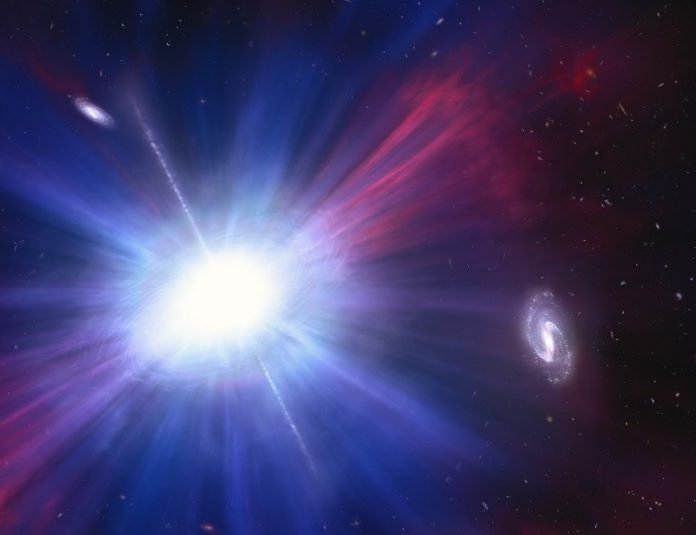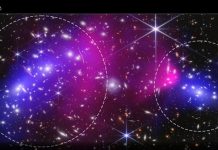
While the night sky may appear tranquil (and incredibly beautiful), the cosmos is filled with constant stellar explosions and collisions.
Among the rarest of these transient events are what is known as Luminous Fast Blue Optical (LFBOTs), which shine intensely bright in blue light and fade after a few days.
These transient events are only detectable by telescopes that continually monitor the sky.
Using the venerable Hubble Space Telescope, an international team of astronomers recently observed an LFBOT far between two galaxies, the last place they expected to see one.
The team was led by astrophysicist Ashley Chrimes, a European Space Agency Research Fellow, formerly of the Institute of Mathematics Astrophysics and Particle Physics (IMAPP) at Radboud University.
He was joined by colleagues from the IMAPP, the 3SRON Netherlands Institute for Space Research, the Cosmic Dawn Center (DAWN), the Niels Bohr Institute, the Institute of Gravitational Wave Astronomy, the South African Astronomical Observatory, and multiple universities and research institutes.
The paper describing their findings will be published in The Monthly Notices of the Royal Astronomical Society.
The first LFBOT was observed in 2018 (AT2018cow) by the Asteroid Terrestrial-impact Last Alert System (ATLAS). This event, nicknamed “The Cow,” was 10–100 times brighter than a normal supernova and took place in a galaxy roughly 200 million light-years (60 million parsecs) away.
Since then, astronomers have detected LFBOTs at a rate of about one a year, so only a handful are known, and very little is known about them. While several theories about their possible causes exist, Hubble’s recent discovery has made this phenomenon even more mysterious.
After its initial detection, the latest LFBOT (AT2023fhn, aka. “The Finch”) was observed by multiple telescopes in various wavelengths – from X-rays to radio waves. The Zwicky Transient Facility, an extremely wide-angle ground-based camera that scans the entire northern sky every two days, was the first to alert astronomers about the event on April 10th, 2023.
Once spotted, the researchers activated a pre-planned program of observations, causing the Gemini Observatory, NASA’s Chandra X-ray Observatory, and the NSF’s Very Large Array (VLA) to train their instruments on The Finch.
The Gemini South telescope in Chile obtained spectroscopic measurements, which revealed that The Finch has a temperature of about 19,980 °C (36,000 °F). It also helped determine its distance from Earth, allowing astronomers to calculate its luminosity.
Combined with Chandra’s X-ray data and radio data from the VLA telescopes, their findings confirmed that the explosion had all the characteristics of an LFBOT. It shined intensely in blue light and evolved rapidly, reaching peak brightness and fading again in a matter of days (whereas supernovae take weeks or months to dim).
But unlike other LFBOTs, Hubble found that the Finch was located about 50,000 light-years from a nearby spiral galaxy and about 15,000 light-years from a smaller galaxy. This raises serious questions about what is driving these massive explosions.
A popular theory is that they are a rare and extremely powerful type of core-collapse supernovae, which occur when massive stars reach the end of their main sequence and explode brilliantly. However, these stars are short-lived by stellar standards, lasting 10-20 million years or up to one hundred million years (depending on their overall mass).
Therefore, massive progenitor stars don’t have enough time to travel far from their birthplace (stellar clusters inside galaxies) before reaching the end of their lifespans. Whereas all previous LFBOTs have been found in the spiral arms of galaxies (where star birth is ongoing), the Finch is an outlier. Said Chrimes in a recent NASA press release:
“The Hubble observations were really the crucial thing. They made us realize that this was unusual compared to the other ones like that, because without the Hubble data we would not have known. The more we learn about LFBOTs, the more they surprise us. We’ve now shown that LFBOTs can occur a long way from the center of the nearest galaxy, and the location of the Finch is not what we expect for any kind of supernova.”
To explain their findings, Chrimes and his colleagues are considering the possibility that it is the result of a collision between two neutron stars that were ejected from their host galaxy and had been spiraling toward each other for billions of years.
These produce kilonovae, which are powerful explosions 1,000 times more powerful than a standard nova and are also a well-known source of Gravitational Waves (GWs). Another theory is that LFBOTs are caused by collisions between neutron stars, where one is a magnetar (a highly-magnetized neutron star).
This would greatly amplify the power of the explosion to the point where it would exceed that of a supernova by a factor of 100. Another possibility is that LFBOTs result from stars being torn apart by an intermediate-mass black hole (between 100 to 1,000 solar masses).
Intermediate-mass black holes are most likely to be found in globular star clusters. In the coming years, NASA’s James Webb Space Telescope (JWST) could be used to see if the Finch exploded in the outer halo of one of the two neighboring galaxies.
At this point, astronomers agree that several more LFBOTs must be discovered before the population can be properly characterized. This will be challenging since transients can happen anywhere, at any time, and are fleeting in astronomical terms (hence the name).
Much like Gamma-Ray Bursts (GRBs) and Fast Radio Bursts (FRBs), the only way to detect them is through wide-field surveys that constantly monitor large areas of the sky. Once detected, space-based and ground-based observatories can conduct follow-up observations to learn more about their properties.
This will be assisted greatly when the Vera C. Rubin Observatory is completed in 2024, one of many next-generation all-sky survey telescopes that will be observing the cosmos shortly. Among its objectives is the study of “objects that change position or brightness over time” – aka transient objects.
Follow us on Twitter for more articles about this topic.
Written by Matt Williams/ Universe Today.



